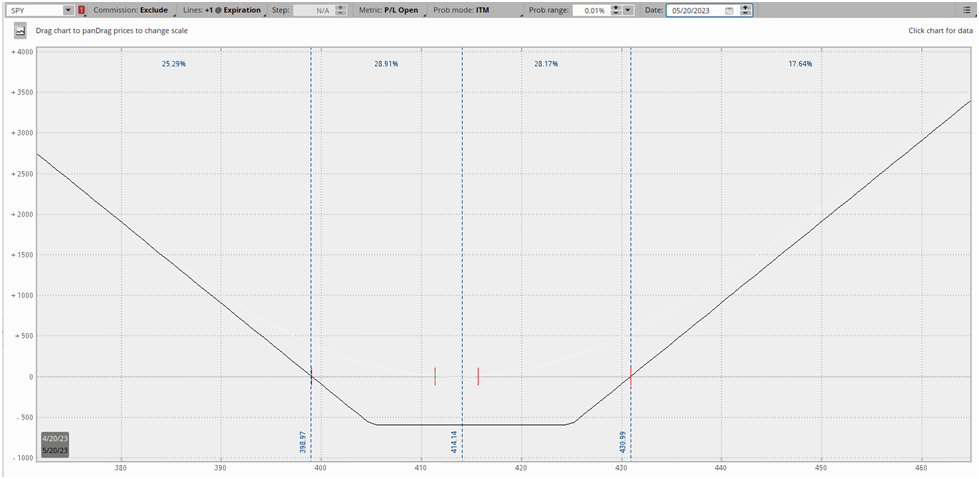The lengthy strangle is sort of much like the favored straddle unfold, the one distinction is that the straddle entails shopping for a put and name on the identical strike worth, whereas the strangle makes use of completely different strike costs.
The commerce is theta detrimental, vega constructive, gamma constructive and (sometimes) delta impartial.
Let’s have a look at an instance in SPY.
- SPY (underlying) worth: $414.00
- BUY (1) 19 MAY $405 PUT @ $3.67
- BUY (1) 19 MAY $420 CALL @ $2.30
- Complete commerce price: $5.97 (internet debit)
On this case, you’re hoping for a big worth transfer in both route, as your break-even worth is commonly fairly removed from the present underlying worth. So that you’d wish to purchase a strangle while you count on substantial market volatility, however while you’re comparatively agnostic concerning the route of that volatility.
An instance of such a state of affairs is that if there’s an necessary upcoming Federal Reserve assembly that you just assume will shock the market, leading to dramatic worth motion.
Right here’s the payoff diagram for this place:
The place turns into worthwhile, or in-the-money, when the worth of SPY trades outdoors of the dotted blue strains at expiration. With this particular unfold expiring in 29 days, you’re enjoying for a reasonably vital market transfer, on this case, you’re anticipating SPY to maneuver up or down roughly 3.6%.
Parts of a Lengthy Strangle
Market Impartial
Strangles make no try and forecast the route the underlying worth will transfer sooner or later. A regular strangle has roughly equal publicity to each will increase and reduces in worth. As an alternative, you’re taking a view on the magnitude of worth motion.
The Lengthy Strangle is a Guess on Elevated Volatility
The lengthy strangle is a Vega constructive technique. While you purchase a strangle, you’re betting on a major worth transfer within the underlying inventory and/or rising implied volatility.
Consider it this fashion. The value of an at-the-money straddle (the “sister” unfold to the strangle) is principally the choice’s market expectations of how a lot worth will transfer till expiration.
You may consider it like a selection in sports activities betting. If the Giants are +140 to beat the Vikings, then the bookies are giving the Giants a 41% likelihood of successful. In case you assume these odds are considerably greater, then it’s best to guess on the Giants.
The identical is true within the choices market. As an illustration, if an ATM straddle in SPY prices $13.84 when SPY is buying and selling at $414, the choices market is pricing in a roughly 3.3% transfer. In case you assume it is going to transfer considerably extra, then you can purchase a protracted volatility unfold like a strangle or straddle.
The Strangle is Destructive Theta
As a result of the strangle is a protracted premium technique, you’re working in opposition to the clock. On account of theta decay, the worth of your choices will slowly lose worth with every passing day, that means the market must make an enormous transfer in a comparatively quick time to make up for theta decay.
The Strangle Has Limitless Revenue Potential
As a result of choices are value their intrinsic worth at expiration and there’s no theoretical restrict to how excessive a inventory can go, a strangle has limitless revenue potential on the upside, with the revenue potential on the draw back solely restricted by the underlying inventory going to zero.
Right here’s a zoomed-out payoff diagram for a visible:
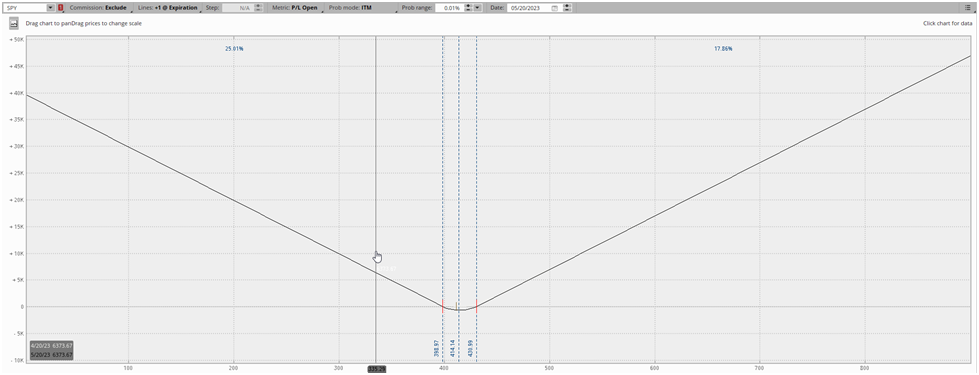
The Strangle Has Restricted Threat
The strangle entails solely shopping for choices, that means that probably the most you’ll be able to lose is the online debit, or the full price of the choices. On this case, that may be the mixed price of each the put and the decision.
Recalling our SPY strangle instance from earlier within the instance:
- SPY (underlying) worth: $414.00
- BUY (1) 19 MAY $405 PUT @ $3.67
- BUY (1) 19 MAY $420 CALL @ $2.30
- Complete commerce price: $5.97 (internet debit)
Probably the most we are able to lose on this case could be $5.97, the online debit or complete price of the commerce.
The right way to Create a Lengthy Strangle Unfold
An extended strangle is a quite simple commerce construction: a put and a name at completely different strike costs with the identical expiration date. The width between the strike costs will be as slim or extensive as you want. You structuring the commerce to suit your particular market view is the place the “special sauce” of choices buying and selling is available in.
Let’s visualize a strangle on an choices chain:
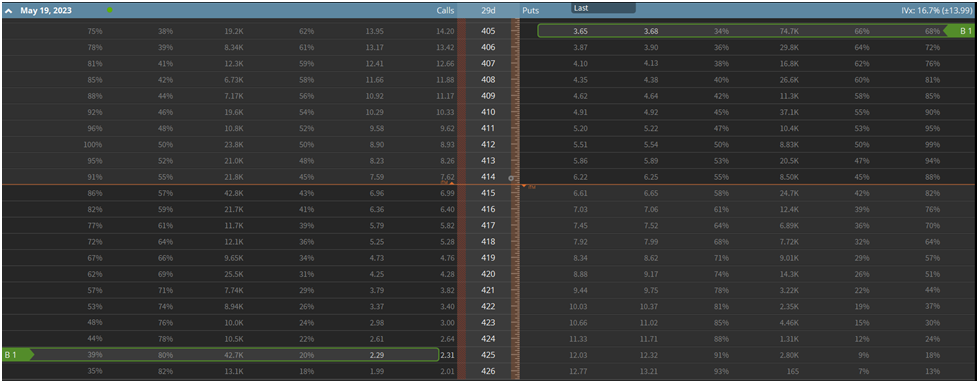
Above is identical SPY lengthy strangle instance we’ve been utilizing all through the article. You’re principally shopping for out-of-the-money (OTM) options that can profit from big worth strikes in both route. The market transfer must not solely be giant sufficient to place certainly one of your OTM choices in-the-money, but in addition pay to your internet debit.
So maybe you conclude the construction we have now above is somewhat costly to your style. You’d quite pay much less for a selection and have a smaller chance of creating a major return in your capital.
You may merely widen the unfold to suit this view. See the desk beneath:
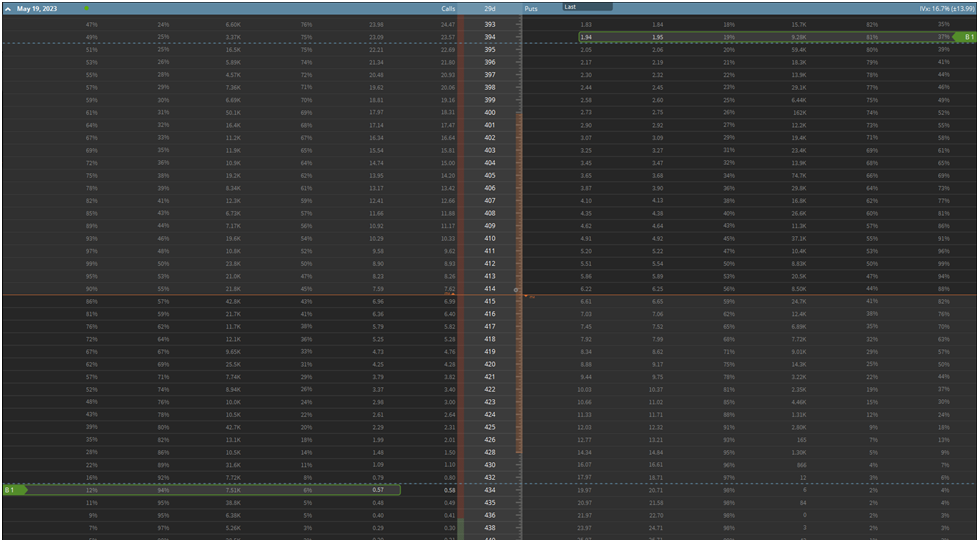
This unfold will price considerably much less at $2.52, nonetheless your chance of profiting on the commerce is way decrease because the market must make a a lot greater transfer to place your commerce within the cash.
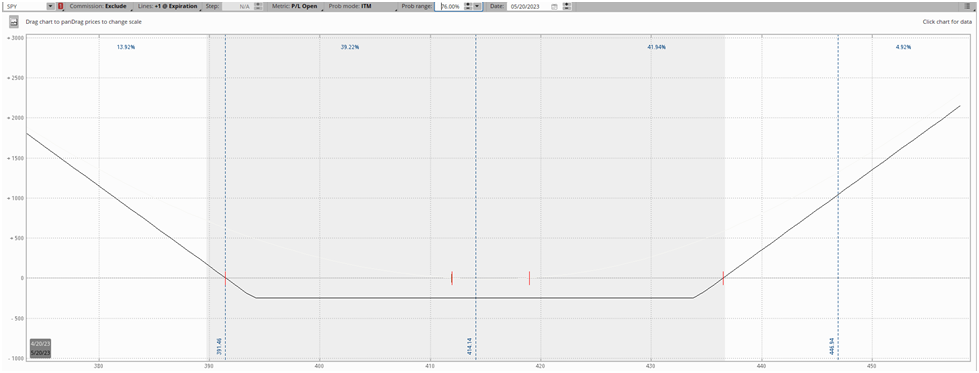
Like several choices commerce, the lengthy strangle is about tradeoffs. You’re looking for the appropriate steadiness between danger and reward. The longer expiration you select, the longer you give your self for the commerce to work, however the extra you pay for the unfold. In case you widen the width between your strikes, your danger/reward is greater, however your chance of profiting on the commerce declines.
For that reason, there’s a variety of issues to make when structuring a protracted strangle unfold.
Strike Width and Strike Choice
Strike choice is a key part of choices buying and selling, it’s typically what defines a worthwhile or shedding commerce. The choice largely comes all the way down to the steadiness between reward/danger ratio and chance of revenue.
As a rule, extensive strike widths have excessive reward/danger ratios and low possibilities of revenue, whereas slim strike widths have comparatively decrease reward/danger ratios and better win charges.
As a degree of demonstration, let’s examine the strangle examples we referred to earlier on this article. In case you recall, the primary one is:
- SPY (underlying) worth: $414.00
- BUY (1) 19 MAY $405 PUT @ $3.67
- BUY (1) 19 MAY $420 CALL @ $2.30
- Complete commerce price: $5.97 (internet debit)
And the second unfold is:
- SPY (underlying) worth: $414.00
- BUY (1) 19 MAY $394 PUT @ $1.95
- BUY (1) 19 MAY $434 CALL @ $0.58
- Complete commerce price: $2.53 (internet debit)
Whereas each of those spreads are long-volatility spreads aiming for large wins, the second unfold has a far greater reward/danger by advantage of the a lot smaller capital outlay. However the first unfold has a a lot better likelihood of expiring in-the-money. The primary unfold has a chance of revenue (POP) of 56%, whereas the second unfold has a POP of simply 25%.
Expiration Date
A really comparable tradeoff is at play when deciding on an expiration date to your choices. In a perfect world, you’d all the time choose the longest expiration date attainable. However in fact, the longer an choice has till expiration, the extra time worth it has and in flip, the costlier it’s.
So we’re consistently seeking to strike the proper steadiness between shopping for ourselves sufficient time to be proper, however not overpaying for time worth a lot that it hurts our reward/danger ratio.
Theta is the first issue to remember right here. The next chart from Investopedia shows the speed of theta decay based mostly on the time to expiration:
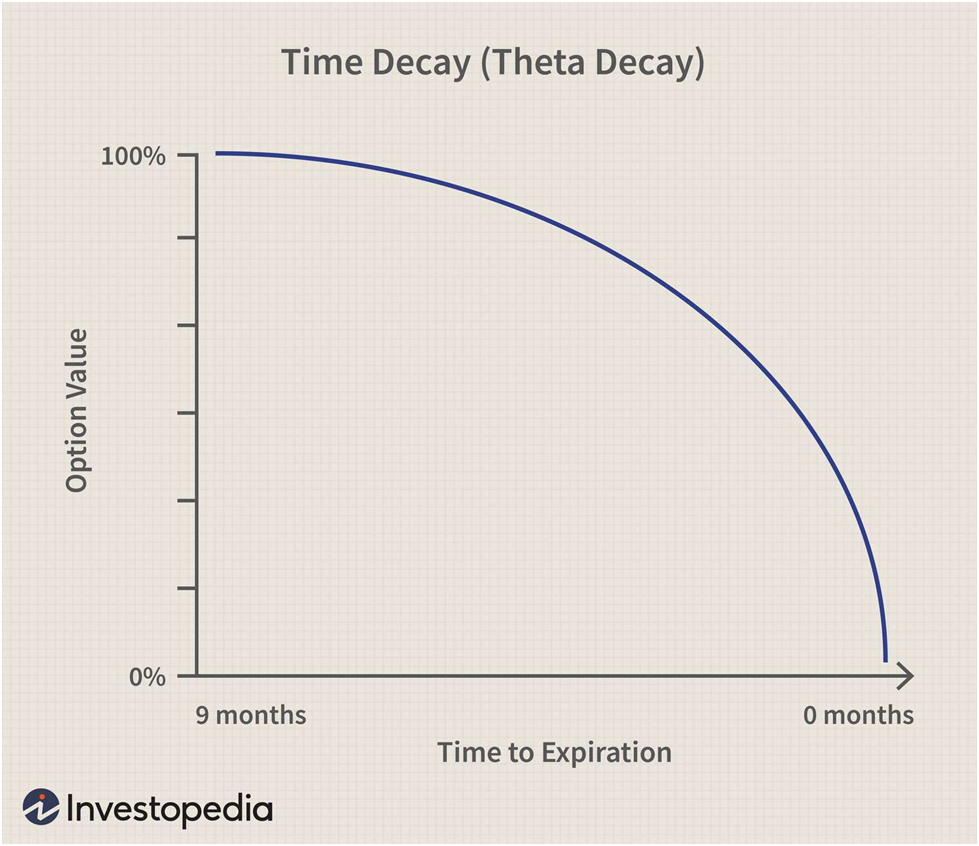
Whereas that is solely a tough information and theta decay shall be barely completely different for every choice, the idea stands. As you get nearer to expiration, the speed of theta decay accelerates.
For that reason, many merchants want to choose longer-dated expirations when shopping for premium. However once more, you’re paying for that additional time worth.
What Are Market Expectations?
In monetary markets, apparent issues are priced-in. Shopping for a high-quality firm like Apple sometimes comes with a heftier valuation than a decrease or mid-tier firm. Everybody is aware of that Apple is an effective firm and the worth displays that. The identical is true to a extra extreme extent within the choices market.
The very best analogy for this idea is in sports activities. The Boston Bruins simply broke the NHL report for many wins in a season at 65. If the Bruins had been going through the Anaheim Geese with solely 23 wins on the season, it’s fairly apparent who’s going to win. You’d by no means guess on the Geese with 50/50 odds. However with 1/99 odds? All of the sudden that looks like a great guess.
To narrate the idea to choices, everybody is aware of {that a} Federal Reserve assembly or earnings report will create volatility. So the choices market, similar to sportsbooks, set “odds” on what’s more than likely to occur. In the identical manner that sportsbooks mirror that the Bruins ought to beat the Geese, the choices market does this to mirror publicly out there data. For this reason shopping for pre-earnings choices is pricey, as a result of everybody is aware of that there shall be elevated volatility.
The easiest way to see what the choice market thinks will occur is pricing out an at-the-money (ATM) straddle.
As an illustration, let’s say we had been excited by betting on earnings on Apple. We’d have a look at the expiration following the corporate’s earnings date on Might 4, 2023 and sum the worth of the ATM name and put, giving us a internet debit of $8.03. This implies the choices market expects the worth of Apple inventory to maneuver plus/minus about $8 on the discharge of earnings.
You may have a look at the ATM straddle because the “moneyline” in sports activities betting. Reasonably than considering when it comes to “the Bruins are the better team, I think they’ll win,” you assume extra when it comes to “I think the Bruins’ probability of winning is higher/lower than the odds.”
So earlier than getting into a protracted strangle, you could guarantee that you’re bullish on volatility relative to market pricing. It’s not sufficient to assume that costs shall be risky, you could assume they’ll be extra risky than what the market is already anticipating. This can be a key idea that many novice merchants take some time to be taught.
Lengthy Strangle Payoff and P&L Traits
Lengthy Strangle Breakeven Costs
The lengthy strangle has two breakeven costs, an higher breakeven and a decrease breakeven. Calculating them is simple.
- Higher Breakeven Price = Name Strike Price + Internet Debit
- Decrease Breakeven Price = Put Strike Price – Internet Debit
As an illustration, right here’s an instance for an Apple strangle:
- $175 Name
- $160 Put
- Internet Debit: $2.60
- Higher Breakeven = $175 + $2.60 = $177.60
-
Decrease Breakeven = $160 – $2.60 = $157.40
Lengthy Strangle Most Loss/Threat
The utmost danger for a protracted strangle is the online debit paid for the unfold. The web debit is just the mixed price of each the put and the decision you buy. Restricted danger methods just like the lengthy strangle are sometimes the constructing blocks for brand spanking new merchants to chop their enamel on, permitting them to be taught with out taking over limitless danger they may not perceive.
Lengthy Strangle Most Revenue
The lengthy strangle has limitless revenue potential as a result of there isn’t a restrict to how excessive or low the underlying inventory worth can go. The one theoretical certain is the inventory going to zero on the draw back.
Lengthy Strangle Market View and Outlook
Matching Market View to Choices Commerce Construction
One factor we’re making an attempt to nail residence on this primer is the significance of matching your market view to the proper choices unfold. As an choices dealer, you are a carpenter, and choice spreads are your instruments. If you could tighten a screw, you will not use a hammer however a screwdriver.
So earlier than you add a brand new unfold to your toolbox, it is essential to grasp the market view it expresses. One of many worst issues you are able to do as an choices dealer is construction a commerce that’s out of concord along with your market outlook.
This mismatch is commonly on show with novice merchants. Maybe a meme inventory like GameStop went from $10 to $400 in just a few weeks. You are assured the worth will revert to some historic imply, and also you wish to use choices to precise this view. Novice merchants ceaselessly solely have outright places and calls of their toolbox. Therefore, they’ll use the proverbial hammer to tighten a screw on this state of affairs.
On this hypothetical, a extra skilled choices dealer would possibly use a bear name unfold, because it expresses a bearish directional view whereas additionally offering short-volatility publicity. However this dealer will be infinitely artistic together with his commerce structuring as a result of he understands easy methods to use choices to precise his market view appropriately.
The nuances of his view would possibly drive him so as to add skew to the unfold, flip it right into a ratio unfold, and so forth.
What Market Outlook Does a Lengthy Strangle Categorical?
The lengthy strangle is delta-neutral, that means merchants shopping for a strangle take no place on worth route. As an alternative, they’re betting on the worth magnitude, whether or not up or down. Put merely, a strangle earnings when the underlying inventory makes an enormous worth transfer in both route.
Positions just like the lengthy strangle or lengthy straddle are sometimes described as being lengthy volatility, which could sound bizarre. To most, volatility is just a calculation or an adjective used to explain chaotic buying and selling. How are you going to “buy volatility?”
While you purchase an choice, you’re having a bet on worth route, time, and volatility. So should you purchase a name, not solely are you betting that the inventory will go up, however that it’s going to go up previous to expiration, and that it’s going to go up greater than the extrinsic worth within the choice price implies. That third half is the volatility side of the equation.
As a result of a strangle entails shopping for each a put and a name, the directional side of the commerce is neutralized, leaving solely the time and volatility elements of the commerce.
So the lengthy strangle dealer is bullish on volatility and impartial on worth. He’s anticipating a big worth transfer.
When To Use a Lengthy Strangle
Earnings
Speculating on earnings is the preferred use for strangles, which entails having a bet {that a} inventory will or gained’t make an enormous transfer following its earnings report.
A dealer would possibly observe {that a} particular inventory tends to habitually make huge strikes on earnings, consumers of strangles earnings quarter after quarter. Acknowledging this, a dealer would possibly purchase a strangle previous to the next earnings report, as long as it doesn’t appear to be the market is adjusting to actuality and making earnings choices costlier.
Right here at SteadyOptions, we want to commerce earnings volatility otherwise than the standard model. We commerce pre-earnings strangles and straddles. In different phrases, we each enter and exit our earnings volatility trades earlier than the earnings occasion ever happens. This might sound totally counter-intuitive however I promise, it is smart.
As a result of implied volatility tends to rise within the lead-up to earnings, we exploit this phenomenon. Primarily, as earnings get nearer, merchants and buyers start shopping for safety within the type of places and shopping for speculative calls, pushing implied volatility up.
We have a tendency to purchase strangles and straddles 2-15 days earlier than an earnings launch and promote earlier than earnings are even launched. On this manner, not solely can we harvest most of the advantages of earnings volatility buying and selling, however we additionally keep away from the grim reaper of lengthy volatility earnings trades: implied volatility (IV) crush, or the phenomenon for IV to plummet instantly following the discharge of an earnings report because the uncertainty that made the IV costly is now gone.
Moreover, the short turnover additionally mitigates detrimental theta, or theta decay, the first danger of shopping for choices.
Different Market Occasions and Catalysts
Whereas earnings is the primary area for volatility buying and selling, a number of different occasions current comparable buying and selling alternatives. A few of these are:
- FDA trials for biotech shares
- Vital financial releases like Federal Reserve conferences, nonfarm payroll, and so on.
- Impending court docket choices for corporations in litigation
- M&A takeover hypothesis
- SEC and federal investigation outcomes
The final idea stands. When there’s a catalyst that can considerably affect an organization’s inventory worth and the market is aware of the date of the catalyst, the identical uptick and crush in implied volatility will happen because it does with earnings releases.
Sure catalysts are extra up within the air and don’t have a definitive date of decision as earnings or a Federal Reserve assembly do. The SEC’s ongoing combat with Coinbase is one such instance. On this case, you would possibly see the implied volatility of such a inventory’s choices elevated for a protracted interval, because the market can’t pinpoint precisely when the catalyst will resolve. Such catalysts are a lot tougher to commerce and are higher left to specialists.
Volatility Imply Reversion
We defined earlier on this article how the lengthy strangle is greater than something, a volatility commerce. You’re having a bet that the underlying inventory’s volatility shall be greater than what the choice market expects. In different phrases, the inventory will make a much bigger transfer than the market thinks it is going to.
So simply as many merchants would possibly systematically purchase shares after big declines, betting that it’s going to revert again to a historic imply, the identical idea exists in volatility buying and selling. As a matter of reality, true imply reversion is far simpler to look at within the volatility buying and selling world than it’s within the inventory buying and selling world.
As an illustration, check out a long-term (12 weeks) shifting common of the S&P 500 Volatility Index (VIX), which is a measure of implied volatility for the S&P 500.
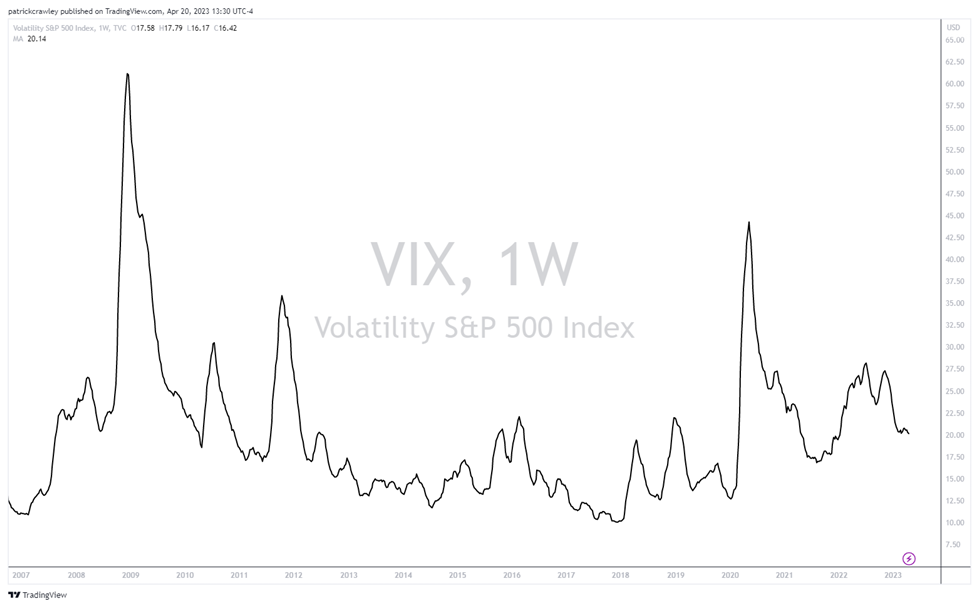
The above chart is a 12-week shifting common of the VIX over the past 15 or so years. As you’ll be able to see, the chart extra resembles an EKG than a inventory worth, that includes semi-predictable peaks and valleys.
The habits of volatility imply reversion is a widely known and accepted phenomenon within the quantitative finance world, with GARCH fashions being the usual strategy to mannequin volatility.
With this in thoughts, many merchants purpose to play these peaks and valleys of volatility. Shopping for when it’s low cost relative to its historic imply, and promoting when it’s costly.
We at SteadyOptions do a fair bit of volatility trading and we want to method it utilizing long-volatility positioning, permitting us to profit from vital spikes in volatility and never expose ourselves to the doubtless catastrophic losses of promoting volatility.
Lengthy Strangle vs. Lengthy Straddle
Strangles and straddles are very similar. They’re each delta-neutral, long-volatility methods that purpose to seize a major worth transfer in both route. Each are used to invest on volatility associated to earnings and different market catalysts.
The first distinction is that straddles contain shopping for a put and name on the identical strike worth whereas strangles contain shopping for a put and name at completely different strike costs.
In apply, whereas a strangle and straddle have very comparable market outlooks, their P&Ls behave otherwise all through the commerce.
The sensible variations are as follows:
- Straddles are inclined to have extra premium than strangles and value extra to provoke a place
- Straddles are inclined to have the next chance of revenue than strangles
- Strangles are inclined to require a bigger transfer to breakeven on the commerce
The easiest way to symbolize these variations is thru every commerce’s payoff diagrams.
A strangle encompasses a extra U-shaped payoff diagram:
:max_bytes(150000):strip_icc()/Strangle2-1d15c8d645af4bc7a7a57be18b4fa331.png)
As you’ll be able to see by the flat line, a strangle is extra of a “do or die” sort of commerce. It both works, otherwise you lose virtually all your premium.
Alternatively, the straddle’s V-shaped payoff diagram implies that very hardly ever will a straddle dealer attain their most loss at expiration:
:max_bytes(150000):strip_icc()/understandingstraddles22-19b55dd41aee458287dda61e4929428a.png)
Backside Line
The lengthy strangle is a straightforward choice unfold. It entails shopping for a put and a name at completely different strike costs and the identical expiration date. Lengthy strangles are betting on an enormous worth transfer and/or IV improve.
Associated articles:
Subscribe to SteadyOptions now and expertise the complete energy of choices buying and selling at your fingertips. Click on the button beneath to get began!

